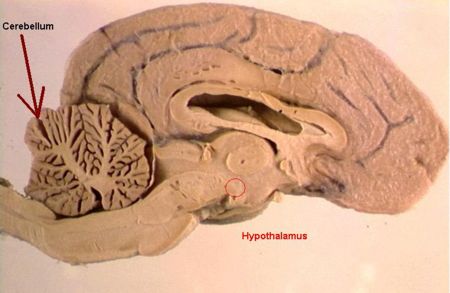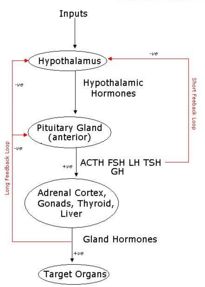Difference between revisions of "Hypothalamus - Anatomy & Physiology"
m (Text replace - "Endocrine System - Anatomy & Physiology|" to "Endocrine System Overview - Anatomy & Physiology|") |
|||
| Line 11: | Line 11: | ||
== Hypothalamus == | == Hypothalamus == | ||
| − | The hypothalamus is a small area in the ventral diencephalon of the [[Forebrain - Anatomy & Physiology|forebrain]], in the floor of the third ventricle, and is a functional link between the [[Nervous and Special Senses - Anatomy & Physiology#Nervous System|nervous]] and [[Endocrine System - Anatomy & Physiology|endocrine]] systems. | + | The hypothalamus is a small area in the ventral diencephalon of the [[Forebrain - Anatomy & Physiology|forebrain]], in the floor of the third ventricle, and is a functional link between the [[Nervous and Special Senses - Anatomy & Physiology#Nervous System|nervous]] and [[Endocrine System Overview - Anatomy & Physiology|endocrine]] systems. |
The hypothalamus controls most of the [[Endocrine Glands - Anatomy & Physiology|endocrine glands]] within the body, largely through stimulation of the [[Pituitary Gland - Anatomy & Physiology|Pituitary Gland]] by secretion of [[Hormones - Anatomy & Physiology#Classifications of Hormones|neurohormones]]. It is a vital regulator of homeostasis, including [[Thermoregulation - Anatomy & Physiology| Thermoregulation]]. | The hypothalamus controls most of the [[Endocrine Glands - Anatomy & Physiology|endocrine glands]] within the body, largely through stimulation of the [[Pituitary Gland - Anatomy & Physiology|Pituitary Gland]] by secretion of [[Hormones - Anatomy & Physiology#Classifications of Hormones|neurohormones]]. It is a vital regulator of homeostasis, including [[Thermoregulation - Anatomy & Physiology| Thermoregulation]]. | ||
Revision as of 16:08, 10 September 2010
|
|
Hypothalamus
The hypothalamus is a small area in the ventral diencephalon of the forebrain, in the floor of the third ventricle, and is a functional link between the nervous and endocrine systems.
The hypothalamus controls most of the endocrine glands within the body, largely through stimulation of the Pituitary Gland by secretion of neurohormones. It is a vital regulator of homeostasis, including Thermoregulation.
Nuclei
| Nuclei | Function |
|---|---|
| Paraventricular | Production of Oxytocin and ADH |
| Supraoptic | Production of Oxytocin and ADH |
| Suprachiasmatic | Circadian Rhythm
Biological Clock |
| Lateral | Arousal |
| Arcuate | Energy |
| Mammilary | Wakefulness |
| Ventromedial | Feeding centre |
| Dorsomedial | Feeding, drinking and regulates body weight |
Inputs
The hypothalamus recieves direct inputs via specific receptors. It also recieves indirect inputs from the blood and nerves.
Direct Inputs via Receptors:
- Thermoreceptors: Neurons in the anterior hypothalamus respond to heat by initiating peripheral vasodilation and sweating. Neurons in the posterior hypothalamus respond to cold by initiating shivering, piloerection and peripheral vasoconstriction. These mechanisms are part of the Thermoregulation system.
- Osmoreceptors: respond to an increase in blood osmolarity by releasing Antidiuretic Hormone (ADH) from the Supraoptic Nucleus which is then secreted by the posterior pituitary and acts to retain water at the kidneys. It also stimulates neurons in the thirst centre in the lateral hypothalamus in an attempt to increase water intake.
- Energy Balance: Neurons in the arcuate nucleus sense blood glucose and hormones. Leptin causes satiety, ghrelin stimulates appetite.
Indirect Inputs from bloodstream include information about:
- Temperature
- Osmotic Pressure
- Hormone concentrations - including Leptin, Cortisol, Oestrogens, Progesterone, Androgens, T3.
Indirect Neural Inputs:
- Uses Visceral and Somatic Sensory neurons, the Limbic System and the Reticular Activating System.
Outputs
- Biological Clock - Light sensed by retina causes stimulation of neurons leading the the suprachiasmatic nucleus which stimulates the Pineal Gland as a result.
- Secretory Neurons - ADH and Oxytocin are released by the Supraoptic and Paraventricular nuclei cell bodies. The axons descend into the Posterior Pituitary gland, where they terminate in blood vessels releasing the hormone directly into circulation. Thus the posterior pituitary acts as a storage site and is not a true endocrine gland.
- Hypothalamic Hormones - the hypothalamus releases hormones which have an activating or inhibitory effect on their target organ, hence they are named Releasing or Inhibitory Hormones respectively.
Releasing Hormones:
- Thyrotropin Releasing Hormone (TRH)
- Growth Hormone Releasing Hormone (GH-RH)
- Gonadotrophin Releasing Hormone (GnRH)
- Corticotropin Releasing Hormone (CRH)
- Prolactin Releasing Hormone (PRL-RH)
Inhibitory Hormones:
- Growth Hormone Inhibiting Hormone aka Somatostatin (GH-IH)
- Gonadotrophin Inhibiting Hormone (GnIH)
- Dopamine (PRL-IH)
Negative Feedback
The Hypothalamus works along with the Pituitary and it's target glands by negative feedback.

